Barberpole Worms - Your Goat's Deadliest Enemy
| From This | To This! |
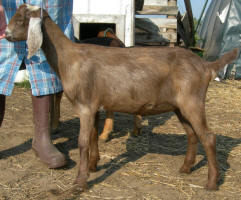 |
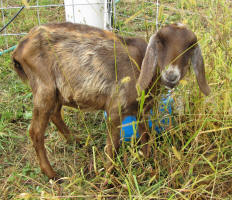  |
| This is Bliss. She is a healthy 7 month old doeling on the left, and near the brink of death as a yearling in the pictures on the right. She weighed less as a yearling than she did as a 7 month old kid. She had lost soooo much weight, her coat was a rough, faded mess, she was dehydrated (despite lots of electrolytes), and was severely anemic. This is the story of her struggle and success over the deadly enemy she was facing. | |
Barberpole worms seem to be the goats worst enemy in this decade. They are silent, not visible to the naked eye, but very deadly. The large majority of wormers do not kill this parasite. The scientific name for Barberpole worms is Haemonchus Contortus. It gets it's name 'Barberpole' from it's red and white striped appearance.
Here are pictures comparing Bliss as a yearling to her half sister, Allie at the same time, same age. Totally different appearance, size and health!!!
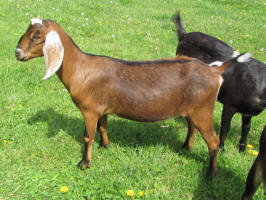

At Green Gables, it took a few years to figure out what was going on as we lost a few animals over two years to seemingly mysterious symptoms. This particular year (2010), I had a yearling (Bliss) and a buck that were just wasting away. Johnes was ruled out. I knew it had to be a parasite, but nothing was working to treat them. The other odd thing was that only a few of the goats were showing problems. Apparently, the others had a higher resistance to the worms which is why they did not show any symptoms. The typical symptoms of barberpole worm infection are:
- Weight loss
- Failure to thrive
- Rough coat
- Sudden drop in milk production
- Some will get diarrhea, but most die before they get to this point
- Swelling around the throat - bottle jaw
- Anemia (visible by checking gums and eyelids)
The problem with Barberpole is that unless you see bottle jaw or get a fecal, it is hard to diagnose as the other symptoms can be caused by any blood sucking parasite. Most all goats will have some barberpole if they have been exposed, just like they have some cocci, but when the parasite gets out of balance with the rest of the system, you have a problem. Barberpole used to be considered a more southern parasite, but has moved north and is well established here now. The year we had such problems with it, I talked with MANY other Wisconsin farmers and found that they were losing many animals to it.
When these two started losing weight, we had fecals done several times, but the local vets always mis-identified the worms. Therefore, the wormers they recommended did not touch the parasites. In addition to trying SafeGuard & Ivomec (per the vet recommendation) we also tried a large number of intensive natural wormers that have been proven over time, but they could not seem to get things under control either. I FINALLY found someone who knew what they were looking at to do fecals. Thanks to Marcy and her correctly identifying the Barberpole worms, we were able to save the doe pictured above and treat the rest of the herd correctly (we did lose the buck). We ended up using Cydectin (which I HATE doing as it is the strongest of wormers, but better that than lose a goat!). It was pretty amazing that Bliss lived. The buck that had it so bad did not make it. The fecal results on Bliss showed astronomically high egg counts. It was amazing that she was still alive. I think the only reason she made it was the intense treatment she was getting - I was out there innumerable times a day giving her electrolytes, activated charcoal, herbs, strengthening foods and coaxing her along. I had, of course, separated her from the rest of the herd when she started having severe scours (about a month before these pictures).
After treating with Cydectin, she slowly came around. I continued to give her the supporting herbs and electrolytes. I used Slippery Elm bark to help her intestinal tract to heal. Barberpole worms bore holes into the intestines where they make their home while they suck the blood of the host. When they are killed, they leave holes in the intestines. The Slippery Elm bark helps it to heal. She also got nettle tea and dried nettles as they are very high in chlorophyll which helps the body to rebuild blood. As Bliss improved, her coat came in sleek and shiny and a beautiful dark chocolate. Her anemia went away and the life came back into her eyes. She gained weight and started growing again (she hadn't grown much since she was 10 months old). She was not recovered enough to breed that fall, but kidded at 3 years old for the first time with gorgeous, healthy twins.
Here is Bliss, healthy and strong, at three years old:
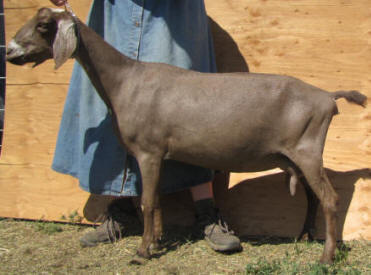
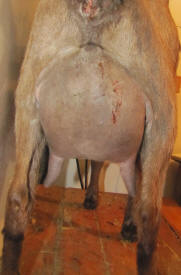
We now try to fecal our herd at least once or twice a year to be sure the parasites stay under control and that the wormer we are using is working. The amazing thing about Bliss is that she now has the lowest egg count of the herd when we do fecals.
